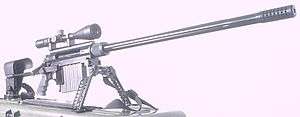EDM Arms Windrunner
| Windrunner M96 | |
|---|---|
 | |
| Type | Sniper rifle |
| Place of origin |
|
| Production history | |
| Manufacturer | EDM Arms |
| Unit cost | US $7,750 [1] |
| Specifications | |
| Weight | 36 lb |
| Length | ∼56 inches |
| Barrel length | 762 mm (30 in) |
|
| |
| Cartridge | .50 BMG, 50 DTC, 408 Cheytac (M96) |
| Action | Bolt-Action |
| Muzzle velocity | ∼853 m/s |
| Effective firing range | ∼1,800 m (2,000 yd) |
| Feed system | 5-round magazine |
The Windrunner M96 is a bolt-action, magazine-fed rifle designed by American firearms designer William Ritchie and manufactured by his company, EDM ARMS. It is chambered for .50 BMG, and a variant designated the M98 is chambered for .338 Lapua Magnum. It was designed to be able to be broken down in less than a minute.[2] The Windrunner rifle was also provided under private label to CheyTac in 2001 and sold as the CheyTac Intervention in .408 and .375 Cheytac. The Windrunner M96 was featured in an article on .50 BMG rifles in the January 2003 issue of Law Enforcement Technology.
EDM ARMS, Inc. has two facilities: one in Hurricane, Utah and another in Chino Valley, Arizona.
As of 2012, EDM ARMS has produced over 3,000 Windrunner Rifles, with sales worldwide. Weapons were deployed in Afghanistan and Iraq.
The 50 BMG Model 96 is the biggest seller.
Current Models from EDM ARMS, Inc.
The following models are currently manufactured by EDM ARMS:
- Model 12 .308 Winchester – 7.62 NATO
- Model 98 .338 Lapua
- Model XM Series 408 Cheytac
- Model 96 50 BMG
- Model 96 50 DTC Cal. Legal
The year 2012 designates another model number for EDM ARMS introducing the Model 12, all the models represent the year in which there were developed and instated to production. The new Model 12 is designated MFG in Chino Valley, Arizona, USA. Available in .308 Winchester – 7.62 NATO, and for varminters the .223 Remington. These new Rifles are CNC machined from pre-hardened 4130 QT chromoly. It is not a new process of machining; most aircraft parts are machined this way. By machining from pre-hard, the heat-treat process is eliminated after the part is complete; this makes for a more accurate system.